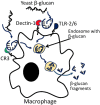Optimizing Tumor Microenvironment for Cancer Immunotherapy: β-Glucan-Based Nanoparticles
- PMID: 29535722
- PMCID: PMC5834761
- DOI: 10.3389/fimmu.2018.00341
Optimizing Tumor Microenvironment for Cancer Immunotherapy: β-Glucan-Based Nanoparticles
Abstract
Immunotherapy is revolutionizing cancer treatment. Recent clinical success with immune checkpoint inhibitors, chimeric antigen receptor T-cell therapy, and adoptive immune cellular therapies has generated excitement and new hopes for patients and investigators. However, clinically efficacious responses to cancer immunotherapy occur only in a minority of patients. One reason is the tumor microenvironment (TME), which potently inhibits the generation and delivery of optimal antitumor immune responses. As our understanding of TME continues to grow, strategies are being developed to change the TME toward one that augments the emergence of strong antitumor immunity. These strategies include eliminating tumor bulk to provoke the release of tumor antigens, using adjuvants to enhance antigen-presenting cell function, and employ agents that enhance immune cell effector activity. This article reviews the development of β-glucan and β-glucan-based nanoparticles as immune modulators of TME, as well as their potential benefit and future therapeutic applications. Cell-wall β-glucans from natural sources including plant, fungi, and bacteria are molecules that adopt pathogen-associated molecular pattern (PAMP) known to target specific receptors on immune cell subsets. Emerging data suggest that the TME can be actively manipulated by β-glucans and their related nanoparticles. In this review, we discuss the mechanisms of conditioning TME using β-glucan and β-glucan-based nanoparticles, and how this strategy enables future design of optimal combination cancer immunotherapies.
Keywords: beta-glucan; beta-glucan-based nanoparticle; cancer immunotherapy; immune modulator; tumor microenvironment.
Figures


Similar articles
-
Yeast-Derived β-Glucan in Cancer: Novel Uses of a Traditional Therapeutic.Int J Mol Sci. 2019 Jul 24;20(15):3618. doi: 10.3390/ijms20153618. Int J Mol Sci. 2019. PMID: 31344853 Free PMC article. Review.
-
Beta-d-glucan-based drug delivery system and its potential application in targeting tumor associated macrophages.Carbohydr Polym. 2021 Feb 1;253:117258. doi: 10.1016/j.carbpol.2020.117258. Epub 2020 Oct 20. Carbohydr Polym. 2021. PMID: 33278940 Review.
-
Consumption of β-glucans to spice up T cell treatment of tumors: a review.Expert Opin Biol Ther. 2018 Oct;18(10):1023-1040. doi: 10.1080/14712598.2018.1523392. Expert Opin Biol Ther. 2018. PMID: 30221551 Review.
-
Engineering Nanoparticles for Targeted Remodeling of the Tumor Microenvironment to Improve Cancer Immunotherapy.Theranostics. 2019 Jan 1;9(1):126-151. doi: 10.7150/thno.29431. eCollection 2019. Theranostics. 2019. PMID: 30662558 Free PMC article. Review.
-
Potential applications of nanoparticles for tumor microenvironment remodeling to ameliorate cancer immunotherapy.Int J Pharm. 2019 Oct 30;570:118636. doi: 10.1016/j.ijpharm.2019.118636. Epub 2019 Aug 22. Int J Pharm. 2019. PMID: 31446027 Review.
Cited by
-
Regulatory effects of IRF4 on immune cells in the tumor microenvironment.Front Immunol. 2023 Feb 6;14:1086803. doi: 10.3389/fimmu.2023.1086803. eCollection 2023. Front Immunol. 2023. PMID: 36814912 Free PMC article. Review.
-
Chronic Inflammation's Transformation to Cancer: A Nanotherapeutic Paradigm.Molecules. 2023 May 29;28(11):4413. doi: 10.3390/molecules28114413. Molecules. 2023. PMID: 37298889 Free PMC article. Review.
-
Mycobiome: an underexplored kingdom in cancer.Microbiol Mol Biol Rev. 2025 Jun 25;89(2):e0026124. doi: 10.1128/mmbr.00261-24. Epub 2025 Mar 14. Microbiol Mol Biol Rev. 2025. PMID: 40084887 Review.
-
In vitro elucidation of antioxidant, antiproliferative, and apoptotic potential of yeast-derived β-1,3-glucan particles against cervical cancer cells.Front Oncol. 2022 Aug 18;12:942075. doi: 10.3389/fonc.2022.942075. eCollection 2022. Front Oncol. 2022. PMID: 36059639 Free PMC article.
-
The Mycobiome: Cancer Pathogenesis, Diagnosis, and Therapy.Cancers (Basel). 2022 Jun 10;14(12):2875. doi: 10.3390/cancers14122875. Cancers (Basel). 2022. PMID: 35740541 Free PMC article. Review.
References
Publication types
MeSH terms
Substances
Grants and funding
LinkOut - more resources
Full Text Sources
Other Literature Sources
Research Materials

